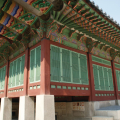Since the 14th century, this palace has captivated by its beauty. It's not for nothing that he's the most famous in the capital.
The Palace of Radiant Happiness was built by King Taejo in 1394 when he established his capital in Seoul. He chose a special geomantic location, just below the Bugak Mountains, facing south towards Namsan and the river, to take advantage of the gi (energy) that flows through this passage. The complex, comprising some 500 buildings, was the seat of power and the royal residence. It was completely burnt down in 1592 during Hideyoshi's invasion, not by the Japanese but by the royal slaves. It was abandoned for 273 years for the Changdeokgung, until the regent Daewongun decided to rebuild it according to the original plans in 1865. Work was completed in 1872. It was only inhabited for 23 years, King Gojong having to take refuge in the Russian legation, then in Deoksugung, following the assassination of Queen Min by the Japanese. In a supremely symbolic move, the Japanese set up their seat of government here, between the throne hall and the Gwanghwamun Gate. They relocated most of the 200 buildings, reducing their number to around ten. Access to the palace is through the Gwanghwamun Gate, Seoul's spiritual center, built in 1395 and the main gateway to the palace. Only the king could pass through the middle entrance, while the 2 side passages were reserved for high-ranking officials. It was destroyed in 1592, rebuilt in the 1860s, then moved by the Japanese to the eastern wall. Its summit was destroyed during the Korean War. In 1968, it was moved back to its original location and restored. President Park ChungHee himself wrote the sign in Hangeul, not Chinese. On the sides, 2 mythical animals, haetae, symbolically protect the palace from fire. It is also possible to enter the complex through the east gate (Geonchunmun). Once inside, the superb 10-storey pagoda appears, donated in 1348 by a Mongol emperor to the Korean king who had to marry his daughter. To the west of the pagoda, the throne hall, Geunjeongjeon (the hall of moderate government), rises up from its magnificent structure in the middle of a paved courtyard. This 2-storey building, built in the 1860s on a double stone terrace, is the largest old wooden hall in the country. It was used for important audiences and ceremonies. The throne is still there, under a carved canopy and in front of a beautiful screen decorated with symbols of longevity. In front of the hall, a paved path leads to the terrace stairs. Only the king could use this passage. The senior officials were lined up to one side, the civilians to the right, the military to the left. Stones lined up along the pathway indicated the place to be occupied by officials according to their rank. The carved motifs on the balustrade, including a phoenix on the inclined plane, symbolizing royal authority, are remarkable. Other halls and secondary pavilions also exist. Those around the throne hall were devoted to the government and administration of the kingdom(chijo). Buildings housing the royal family were located further back, in the inner palace, such as Gangnyeongjeon, where the king lived, and Gyoetaejeon, the queen's main residence, both rebuilt in 1994. The buildings, most of which were moved to Changdeokgung in 1919 or destroyed by the Japanese, are now being rebuilt. You have to imagine this palace as a succession of walls, open and closed corridors, galleries, courtyards and enclosures: a veritable labyrinth comparable to Beijing's Forbidden City. The halls and pavilions themselves were quite modest in size compared to Western royal residences, but very numerous, each with an assigned function. The king resided in the inner palace(yeonjo), at the "top" or center of this compartmentalized, structured complex that evokes the values of this Confucian society: his person and intimacy were thus virtually inaccessible. To the west, the magnificent Gyeonghoeru (Happy Assembly Pavilion) is one of Korea's largest pavilions, with 48 pillars overlooking a pool. Built in 1412, it was destroyed in 1592, rebuilt in 1867, damaged again during the Korean War and finally badly restored.) It was used for official celebrations and receptions, and even as a venue for the national gwageo competition. Jagyeongjeon was the residence of certain members of the royal family. Its surrounding wall is well preserved. A private audience hall, the Hamhwadang, stands opposite a lotus-filled pool reserved for the relaxation of the king and his family. A bridge leads to a small island with a beautiful pavilion, the Hyangwonjeong. The Donggung was the part of the palace reserved for the prince. Jaseongdang and Bihyeongak, the living quarters of the prince and his wife, were rebuilt in 1999. The palace perimeter wall has been preserved, with the exception of the recently built southern section. The south, east and north gates are original. At the far end of the complex are the Academy of Arts and Sciences, the Museum of Arts and Crafts and, above all, the Folklore Museum. All in all, a must-see.
Did you know? This review was written by our professional authors.
Members' reviews on GYEONGBOKGUNG PALACE (RADIANT HAPPINESS)
The ratings and reviews below reflect the subjective opinions of members and not the opinion of The Little Witty.










When I purchased at the window it wasn't entirely clear that a single ticket covered my group. When I enquired whether the other members didn't require a pass (as seniors), the lady serving screamed at me that it was a ticket for everyone, as if I should have known straight away.
Firstly, it wasn't obvious, because the ticket's admission details were written in Hangul (which I can't read). Even if I could read it, was it really necessary to treat visitors this way.
And if the staff insist that this pathetic attitude is the correct way to conduct themselves, then I recommend avoiding this place altogether.